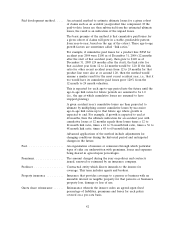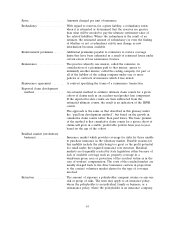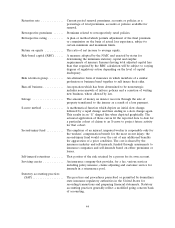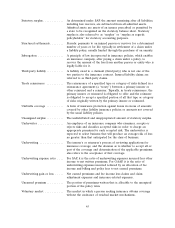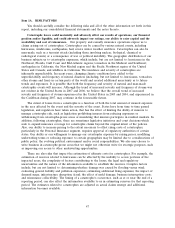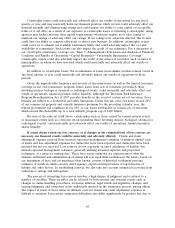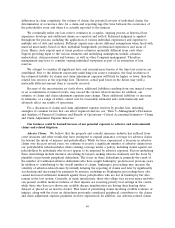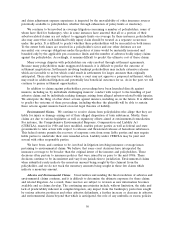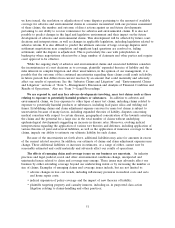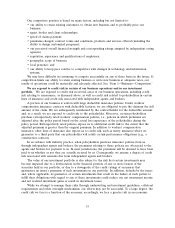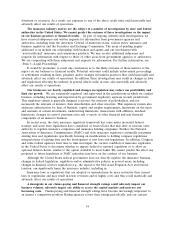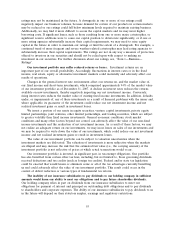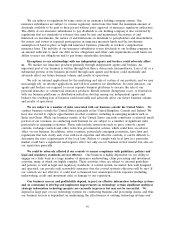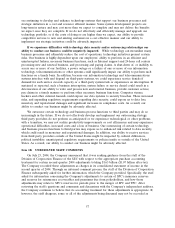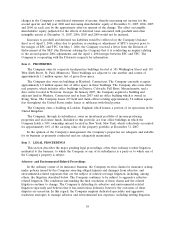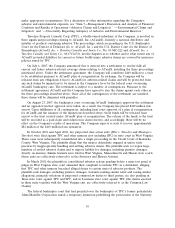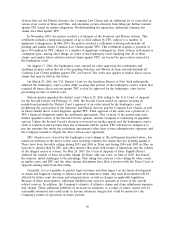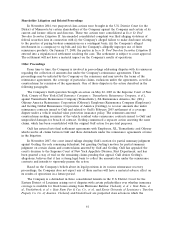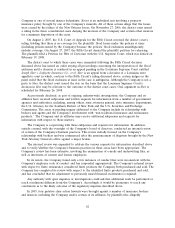Travelers 2007 Annual Report Download - page 64
Download and view the complete annual report
Please find page 64 of the 2007 Travelers annual report below. You can navigate through the pages in the report by either clicking on the pages listed below, or by using the keyword search tool below to find specific information within the annual report.• increases in the number and size of claims relating to construction defects, which often present
complex coverage and damage valuation questions;
• claims from directors’ and officers’ insurance relating to policyholders’ losses from involvement
in financial market activities, such as mortgage or financial product origination, distribution or
structuring, possible accounting irregularities, and corporate governance issues;
• the assertion of ‘‘public nuisance’’ theories of liability, pursuant to which plaintiffs seek to
recover monies spent to administer public health care programs and/or to abate hazards to
public health and safety; and
• medical developments that link health issues to particular causes, resulting in liability claims.
In some instances, these emerging issues may not become apparent for some time after we have
issued the affected insurance policies. As a result, the full extent of liability under our insurance
policies may not be known for many years after the policies are issued.
The effects of these and other unforeseen emerging claim and coverage issues are extremely hard
to predict and could harm our business and materially and adversely affect our results of operations.
We may not be able to collect all amounts due to us from reinsurers, and reinsurance coverage
may not be available to us in the future at commercially reasonable rates or at all. We use
reinsurance to help manage our exposure to property and casualty risks. The availability and cost of
reinsurance are subject to prevailing market conditions, both in terms of price and available capacity,
which can affect our business volume and profitability. Although the reinsurer is liable to us to the
extent of the ceded reinsurance, we remain liable as the direct insurer on all risks reinsured. As a
result, ceded reinsurance arrangements do not eliminate our obligation to pay claims. Accordingly, we
are subject to credit risk with respect to our ability to recover amounts due from reinsurers. In the
past, certain reinsurers have ceased writing business and entered into runoff. Some of our reinsurance
claims may be disputed by the reinsurers, and we may ultimately receive partial or no payment. This is
a particular risk in the case of claims that relate to insurance policies written many years ago, including
those relating to asbestos and environmental claims. In addition, in a number of jurisdictions,
particularly the European Union and the United Kingdom, a reinsurer is permitted to transfer a
reinsurance arrangement to another reinsurer, which may be less creditworthy, without a counterparty’s
consent, provided that the transfer has been approved by the applicable regulatory and/or court
authority. The ability of reinsurers to transfer their risks to other, less creditworthy reinsurers impacts
our risk of collecting amounts due to us. Accordingly, we may not be able to collect all amounts due to
us from reinsurers, and reinsurance coverage may not be available to us in the future at commercially
reasonable rates or at all, and thus our results of operations could be materially and adversely affected.
The intense competition that we face could harm our ability to maintain or increase our
profitability and premium volume. The property and casualty insurance industry is highly competitive,
and we believe that it will remain highly competitive in the foreseeable future. We compete with both
domestic and foreign insurers, some of which have greater financial resources than we do. In addition,
several property and casualty insurers writing commercial lines of business now offer products for
alternative forms of risk protection, including large deductible programs and various forms of
self-insurance that utilize captive insurance companies and risk retention groups. Continued growth in
alternative forms of risk protection could reduce our premium volume. Following the terrorist attack on
September 11, 2001 and again following the hurricane activity in 2005 and 2004, a number of new
insurers and reinsurers were formed to compete in the industry, and a number of existing market
participants raised new capital to enhance their ability to compete. The Company expects property
casualty market conditions to continue to become more competitive in 2008, particularly for new
business. See ‘‘Item 7- Management’s Discussion and Analysis of Financial Condition and Results of
Operation-Outlook’’.
52


